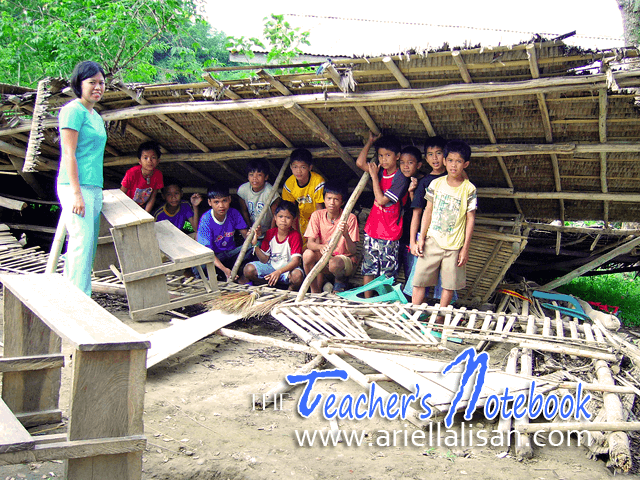THE GOVERNMENT’S efforts in reforming the education sector is laudable. Indeed, the department needs major reforms. The big question is this: Will these reforms address the deeply-rooted problem in education?
The problems in the education sector is manifested in many other socio-economic problems that the country is facing. One is unemployment. Although this problem cannot be blamed solely on education, the latter is one of its root causes.
Addressing the manifestations does not completely solve the problems. Unless we scratch beneath the surface, the problems would keep coming back. Even an anti-fungal cream advertisement knows that.
The Department of Education must address the problems in the schools first before introducing another radical change such as the Enhanced K+12 Basic Education Program.
Infrastructure
When we went to a far-flung school in our town, we were welcomed by this sight: a torn down makeshift classroom at Sofan Elementary School. The school’s Parents-Teachers Association had to build a classroom from round wood with thatched palm leaves for a roof and desks made from rough wooden slabs, because the classrooms in the said school are insufficient.
The situation in other schools is not very far from what you see in the picture above.
Even in our school, which is a Regional Science High School, a school designed to be a center of excellence in science and mathematics education, face the same problem of insufficient classrooms. We are using our laboratories as classrooms and we also had to build a makeshift classroom.
If we increase the number of years that the students will be staying in high school, we would need to build more classrooms or hold classes in several shifts as is being done in schools with big population. The latter, however, has a number of drawbacks. High school students attending nigh classes is way too risky.
The problem is not only on the number of classrooms but also the quality of the classrooms. Many classrooms lack proper ventilation and lighting. In one school where I had my practice teaching, students complain of the discomforts they have to endure in the classroom. That is why they prefer to stay outside or somewhere else, depriving themselves of the learning they should have earned. But how can one learn when they have to mind the noise, the heat, and other discomforts?
As a result of this, the teachers are forced to devote more time on classroom management instead of delivering the lesson.
Books and Other Instructional Materials
Another reason why students lose interest in school is the lack of books and other instructional materials. One of the biggest challenges that public school teachers face is to motivate the students to learn. However, given the very limited resources, teachers would find it hard to motivate the students.
Students can be better engaged in the learning process if they are active participants in it. Then again, with the limited resources in schools, the teacher remains to be the sole source of information. Worse, many teachers teach subjects which are not their major. Given this, how can quality education be achieved?
Teachers
With the current 10-year education cycle, the number of teachers in the public school is barely enough. Even with the local school boards, which deploy locally-paid teachers to needy schools, many teachers still handle more than six hours of teaching load per day.
Aside from long hours of teaching, the number of students per classroom is another problem. If even here at the Regional Science High School where we have a maximum of 40 average and above-average students in the classroom, we still find it hard to manage the conduct of interactive student activities, how much more in regular school where there are over 60 students in the classroom. Naturally, the teachers would choose a strategy that would require minimal preparations of materials — the lecture method that only allows students up to 5% of information retention.
Teachers in public schools have so much burden that could hamper the delivery of their daily lessons and affecting the learning of the students.
I am still wishing that one day teachers could focus on delivering their lessons, updating their knowledge and skills, and ultimately, effectively preparing the students for the world of work, entrepreneurship and higher learning.
These are only three of the perennial problems in public schools that the government has to pay attention to before implementing the new curriculum.
In order to address these problems, the government has to increase its spending on the education sector. Former DepEd Undersecretatry and current education adviser of Pres. Noynoy Aquino, Juan Miguel Luz in an inetrview with ANC estimates that government needs to spend about P100-Billion to realize the Enhanced K+12 Basic Education Program.
If the government will ever spend that money on education, we only hope that it would go to where it rightfully should.





